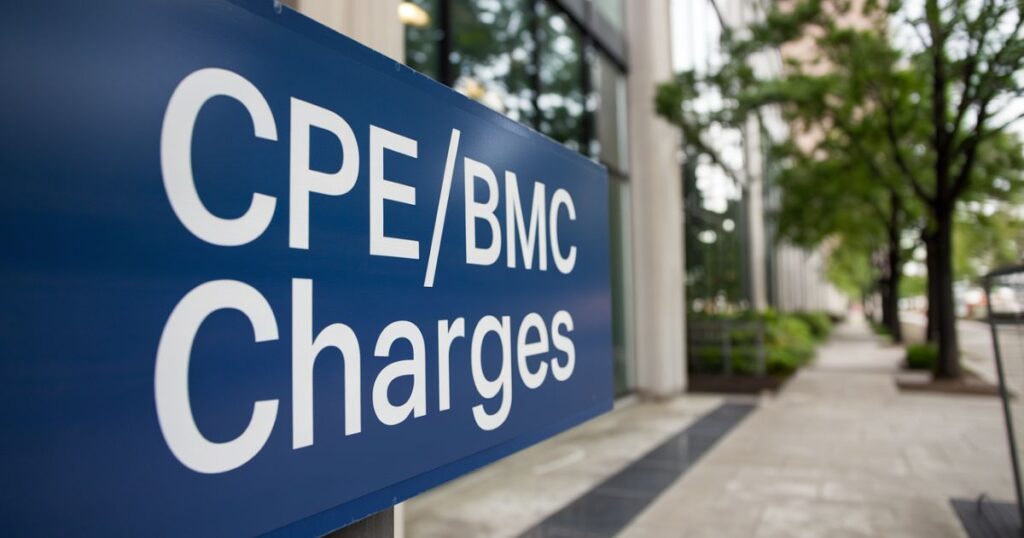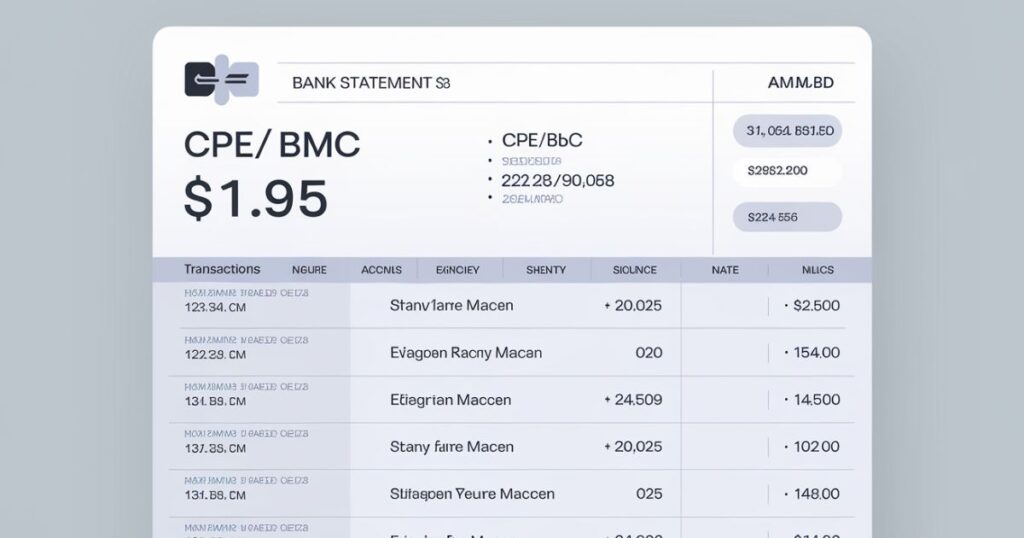CPE/BMC stands for Card Present Entry and Billing Merchant Code. These terms appear on banking statements to describe specific types of transactions. CPE indicates that a physical card was used for the purchase, while BMC identifies the merchant category where the transaction occurred.
Have you ever squinted at your bank statement, puzzled by a mysterious CPE/BMC charge? You’re not alone. Millions of Americans find themselves scratching their heads over these cryptic entries. It’s like trying to decipher a secret code hidden in your financial records.
These charges typically represent everyday purchases made with your credit or debit card. They can include anything from grocery runs to gym memberships. Understanding CPE/BMC charges is crucial for managing your finances effectively and spotting any unauthorized fees quickly.
Describes a CPE/BMC Charge
A CPE/BMC charge is like a secret code on your credit card or debit card statement. CPE stands for “Card Present Entry,” which means your card was physically used for the purchase. The financial world says, “Yep, you were there!”
On the flip side, BMC stands for “Billing Merchant Code.” This is a fancy way of categorizing the type of business where you spend your hard-earned cash. Think of it as a price tag for the retailer. It helps your bank keep track of where your money’s going.
Typical Motives Behind CPE/BMC Charges

Now that we’ve cracked the code, let’s explore why these charges appear on your statement. It’s not always as straightforward as you might think; understanding the reasons can help you keep better tabs on your spending.
Personal Purchases In-Person
When you swipe, dip, or tap your card at a store, restaurant, or other physical location, you’re likely to see a CPE/BMC charge. It’s the digital footprint of your real-world shopping adventures. Maybe you treated yourself to a new gadget or enjoyed a fancy dinner, but these in-person splurges often appear as CPE/BMC charges.
Service Subscription Plans
Have you ever signed up for a gym membership or magazine subscription in person? These recurring payments might show up as CPE/BMC charges, too. It’s like your card says, “Remember that fitness commitment you made? Yeah, we’re still doing that.”
Unknown Marketers
Sometimes, the merchant name on your statement looks like gibberish. This can happen when small businesses or franchises use different invoicing identities. It’s not necessarily fishy, but it can sure be confusing!
Where You Might View CPE/BMC Charges
CPE/BMC charges can pop up in various places, depending on how you manage your money. Let’s look at the most common spots where these mysterious entries lurk.
Statements of Credit Cards
Your credit card statement is prime real estate for CPE/BMC charges. These entries often reflect purchases where you physically presented your card. It’s like a financial breadcrumb trail of your spending habits.
Statement of Debit Cards
Don’t think your debit card is off the hook! CPE/BMC charges can show up here, too, especially for point-of-sale transactions. Your bank says, “Yep, you used your card for that purchase.”
Statements of Bank Accounts
Even your regular bank account statements might feature CPE/BMC charges, particularly if you have a card linked to the account. It’s like a financial family reunion – all your transactions coming together in one place.
Identifying a CPE/BMC Charge: Methods
Playing detective with your finances? Here are some sleuthing techniques to help you crack the case of the mysterious CPE/BMC charge.
Examine the transaction date.
The date of the transaction can be your first clue. Does it ring any bells? Try to match it with your recent shopping trips or bill payments. It’s like piecing together a financial puzzle.
Review the merchant’s name.
Sometimes, the merchant’s name is as clear as day, but other times, it’s like trying to read ancient hieroglyphics. A quick Google search can often clear up the mystery. It’s like being a financial archaeologist!
Match the Scale.
Look at the amount of the charge. Does it align with any recent purchases? This can help jog your memory about that coffee run or online shopping spree. It’s like playing “Name That Tune,” but with your money!
Guidelines for Responding to a CPE/BMC Charge
Have you spotted a CPE/BMC charge that’s raising your eyebrows? Don’t panic! Here’s a roadmap to help you navigate this financial puzzle confidently and easily.
One should check the transaction.
Before sounding the alarm, take a deep breath and review your recent spending. Check your receipts, dig through your email for order confirmations, or ask your partner if they made any purchases. It’s like being your financial detective!
Talk to the merchant.
If you’re still unsure, contact the business directly. They can often provide more details about the transaction. It’s like asking for directions when you’re lost. Most merchants are happy to help clarify things.
Track for Recurring Charges.
Some CPE/BMC charges might be from subscription services or monthly bills. Watch out for repeat offenders. It’s like watching for recurring characters in your favorite TV show. They’ll keep popping up!
Calling Your Credit Card Company or Bank
Sometimes, you need to bring in the big guns. If you’re still unsure about a charge, it’s time to give your financial institution a ring. Here’s how to make that call count.
Compile data.
Before you dial, gather all the info you can about the charge, the date, amount, merchant name, and the works. It’s like prepping for a test, but you’re protecting your money instead of grades.
Describe the scenario.
When you get a representative on the line, explain your situation clearly and give them all the details you’ve gathered. It’s like painting a picture with words; the more vivid they are, the better they can help.
Use Their Advice.
Listen carefully to what the representative suggests. They recommend monitoring your account or filing a dispute. It’s like getting a personalized financial roadmap – follow it closely!
Stopping Unauthorized Fees
Prevention is better than cure, especially regarding your hard-earned cash. Let’s explore some strategies to avoid those pesky unauthorized fees.
Pay with Safe Techniques
Opt for secure payment methods whenever possible. Contactless payments, chip cards, and reputable digital wallets can add an extra layer of protection. It’s like putting a force field around your money!
Check Your Statements Regularly
Make it a habit to review your statements frequently. Set a reminder if necessary. It’s like giving your finances a regular health check-up to catch any issues early!
Create Alerts.
Many banks offer transaction alerts. Set these up to receive real-time notifications about purchases. It’s like having a personal financial bodyguard watching your accounts 24/7.
Arguing a CPE/BMC Charge
Sometimes, you need to stand your ground and contest a charge. Here’s how to build a strong case and get your desired resolution.
Compile Evidence
Gather all relevant documents – receipts, correspondence with the merchant, and anything that supports your case. It’s like preparing for a court case, but you’re convincing your bank instead of a judge.
Speak with Your Financial Institution
Contact your bank or credit card company to initiate the dispute procedure. Clearly explain why you’re contesting the charge. It’s like presenting your case to a jury – be clear, concise, and convincing.
Check-In Action
Don’t just file the dispute and forget about it. Follow up regularly to check on the progress. It’s like nurturing a plant – a little attention goes a long way in getting the results you want.
Track Your Notes
Keeping detailed records can be your secret weapon in managing your finances effectively. Let’s dive into some strategies for staying organized and on top of your game.
Arrange frequent reviews.
Set a schedule for reviewing your finances. Weekly, bi-weekly, monthly – whatever works for you. It’s like having a regular date with your money – keep it consistent!
Look for differences.
When reviewing your statements, look for unusual patterns or discrepancies. It’s like playing a financial version of “Spot the Difference,” but the stakes are just a bit higher!
Maintain Documentation.
Keep all your financial documents organized and easily accessible. Whether you use a physical filing system or a digital solution, find what works for you. It’s like creating a financial scrapbook but way more useful!
Alerts & Notifications
In this digital age, let technology be your ally in managing your finances. Setting up the right alerts can be like having a personal financial assistant working around the clock.
Create transaction alert systems.
Most banks offer customizable alert systems. Take advantage of these to stay on top of your spending. It’s like having a financial early warning system – catch potential issues before they become problems!
Customize Alert Levels
Tailor your alerts to your specific needs and spending habits. Set different thresholds for different types of transactions. It’s like creating a personalized financial security system – you decide what triggers the alarm!
Immediately Review Alerts
When you receive an alert, don’t ignore it. Take a moment to verify the transaction. It’s like responding to a fire alarm – quick action can prevent a small issue from becoming a big problem!
Knowing Various Merchant codes
Merchant codes seem like a foreign language, but understanding them can give you valuable insights into your spending habits. Let’s decode this financial cipher!
Master Common Codes
Familiarize yourself with frequently used merchant codes. It’s like learning a new language – start with the basics and build from there.
Utilize Internet Resources
There are plenty of online resources that can help you decipher merchant codes. It’s like having a financial translator at your fingertips – use it whenever you’re stumped!
Speak with Your Bank
Don’t hesitate to ask your bank if you’re still unsure about a particular code. They’re the experts, after all. It’s like consulting a financial dictionary – they’ve got all the definitions you need!
How Credit Affects CPE/BMC Charges
Your credit and CPE/BMC charges are more intertwined than you might think. Understanding this relationship can help you maintain a healthy credit score.
Check your credit report.
Review your credit report regularly to ensure all CPE/BMC charges are accurately reflected. It’s like giving your credit a health check-up to catch any issues early!
Quickly Correct Reports
If you spot any errors related to CPE/BMC charges on your credit report, act fast to get them corrected. It’s like nipping a financial weed in the bud – don’t let it grow into a bigger problem!
Respect Your Rights
Familiarize yourself with consumer protection laws related to credit reporting and CPE/BMC charges. Knowing the rules of the financial game empowers you to play better!
What Shall You Do On Seeing CPE/BMC Charges?

When you spot a CPE/BMC charge on your statement, don’t panic! Take a deep breath and approach it methodically. First, try to recall if you made any purchases that could match the charge. Check your receipts emails, or ask family members if they used your card.
If you can’t identify the charge, don’t hesitate to contact your bank or the merchant for clarification. Remember, it’s your money; you have every right to understand where it’s going. Stay vigilant, but remember that most CPE/BMC charges are legitimate – they’re just coded in a way that might not be immediately clear to you.
Recommended Blog: Decoding Cotflt: Why It’s Trending In 2024
Conclusion
Understanding CPE/BMC charges is like learning to read a new financial language. It might seem daunting at first, but you’ll become fluent in no time with practice. Remember, these charges are usually a normal part of your financial life, reflecting your day-to-day transactions and subscriptions.
You’re taking control of your financial health by staying informed, regularly reviewing your statements, and acting quickly on any suspicious activity. It’s not about becoming paranoid but about being proactively aware. After all, your money works hard for you – it deserves your attention and care.
So, the next time you see a CPE/BMC charge on your statement, you’ll know exactly what it means and how to handle it. You’re now equipped with the knowledge to navigate this aspect of your finances confidently. Here’s to smarter spending and savvier saving!
FAQs
What is the full form of CPE in banking?
CPE in banking stands for Card Present Entry. It indicates a transaction where your physical card was used for a purchase.
What is the bank activity fee?
The bank activity fee is a charge some banks impose for maintaining your account or for certain transactions. It varies by bank and account type.
What are the fees on my bank statement?
Fees on your bank statement are charges for various services or account activities. These can include maintenance fees, ATM fees, or overdraft charges.
What is the CCC bank charge?
CCC bank charge likely refers to a specific merchant or transaction code. It could be related to a particular type of purchase or service, but its exact meaning can vary by bank.

As a writer with a deep focus on bank statements and credit card issues, I’m committed to unraveling the complexities of financial matters. I specialize in identifying and addressing fraudulent transactions, providing readers with clear, actionable insights. My goal is to make finance less daunting and more accessible, helping others navigate their financial journeys with confidence.






